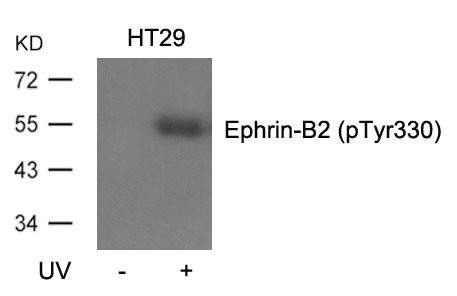
Western blot analysis of extracts from HT29 cells, untreated or treated with UV using Ephrin-B2(Phospho-Tyr330) Antibody.
Phospho-EFNB2 (Tyr330) Antibody
CSB-PA216331
ApplicationsWestern Blot, ELISA
Product group Antibodies
ReactivityHuman, Mouse
TargetEFNB2
Overview
- SupplierCusabio
- Product NamePhospho-EFNB2 (Tyr330) Antibody
- Delivery Days Customer20
- ApplicationsWestern Blot, ELISA
- CertificationResearch Use Only
- ClonalityPolyclonal
- ConjugateUnconjugated
- Gene ID1948
- Target nameEFNB2
- Target descriptionephrin B2
- Target synonymseph-related receptor tyrosine kinase ligand 5; ephrin-B2; EPLG5; HTK ligand; HTKL; Htk-L; LERK5; ligand of eph-related kinase 5
- HostRabbit
- IsotypeIgG
- Protein IDP52799
- Protein NameEphrin-B2
- Scientific DescriptionAdducins are a family of cytoskeleton proteins encoded by three genes (a, beta, gamma). Adducin is a heterodimeric protein that consists of related subunits, which are produced from distinct genes but share a similar structure. a- and beta-adducin include a protease-resistant N-terminal region and a protease-sensitive, hydrophilic C-terminal region. a- and gamma-adducins are ubiquitously expressed. In contrast, beta-adducin is expressed at high levels in brain and hematopoietic tissues. Adducin binds with high affinity to Ca(2+)/calmodulin and is a substrate for protein kinases A and C. Alternative splicing results in multiple variants encoding distinct isoforms; however, not all variants have been fully described. Chrencik JE,et al.( 2006) J Biol Chem;281(38):28185-28192. Kertesz N, et al. (2006) Blood; 107(6):2330-2338. Noren NK, et al. (2004) Proc Natl Acad Sci USA; 101(15):5583-5588.
- ReactivityHuman, Mouse
- Storage Instruction-20°C or -80°C
- UNSPSC12352203
